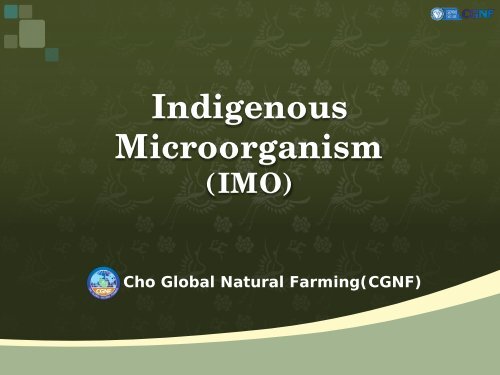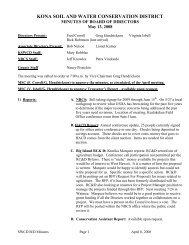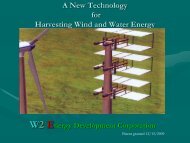Dr. Hoon Park III - Indigenous Microorganism (IMO).pdf
Dr. Hoon Park III - Indigenous Microorganism (IMO).pdf
Dr. Hoon Park III - Indigenous Microorganism (IMO).pdf
You also want an ePaper? Increase the reach of your titles
YUMPU automatically turns print PDFs into web optimized ePapers that Google loves.
<strong>Indigenous</strong><br />
<strong>Microorganism</strong><br />
(<strong>IMO</strong>)<br />
Cho Global Natural Farming(CGNF)
In a variety of soil microorganisms.<br />
Their own ability and strength to live and<br />
find out alive.<br />
Environment, ability to cope.<br />
Soil Environment.<br />
CGNF<br />
2
Ability to decompose organic compounds.<br />
Catalysis of chemical processes in the soil.<br />
Natural ecosystems to facilitate recovery.<br />
Suppression of diseases by circulating<br />
naturally active materials.<br />
CGNF<br />
3
Time of collection<br />
<strong>IMO</strong> can be collected at any time<br />
Period of collection<br />
In the spring and fall: 7~10 days<br />
In the summer: 4~5 days<br />
Place of collection<br />
Arable fields and closest<br />
Field is slightly higher than<br />
CGNF<br />
4
Materials for collecting<br />
▪ "Lunch box" (A square or rectangular box made of n<br />
atural materials such as Japanese cedar or bamboo.)<br />
▪ Low moisture rice (less moisture to collect aerobic<br />
microbes)<br />
▪ White paper through the air<br />
(Korean name ‘Hanji’ or paper towel)<br />
▪ Rubber band or rice straw<br />
▪ Container box (to protect the wooden lunch box from<br />
animals and to mark the location)<br />
CGNF<br />
5
Collection site<br />
▪ The sweetness from the roots of crops.<br />
- Near the roots of bamboo<br />
- leaf mold of broadleaved<br />
▪ Rice stump<br />
▪ It is better to collect in a slightly barren area<br />
rather than in a nutrient-rich area.<br />
CGNF<br />
6
CGNF<br />
7
CGNF<br />
8
CGNF<br />
9
CGNF<br />
10
CGNF<br />
11
CGNF<br />
12
Aerobic microorganisms<br />
Color : White<br />
The smell of yeast floating<br />
Warm temperatures<br />
CGNF<br />
13
CGNF<br />
14
Materials<br />
▪ <strong>IMO</strong>#1<br />
▪ brown sugar<br />
▪ Clay jar<br />
▪ White paper through the air<br />
(Korean name ‘Hanji’ or paper towel)<br />
▪ Rubber band or rice straw<br />
CGNF<br />
15
Mix <strong>IMO</strong> #1 with brown sugar in 1:1<br />
ratio (weight) and then put it in the jar.<br />
Fill 2/3 of the clay jar with the mixture.<br />
This creates the most favorable environment f<br />
or fermentation.<br />
Cover the clay jar with paper and tie it with a<br />
rubber band or straws.<br />
Fermentation temperature : 23-25˚C<br />
Fermentation period : 7days<br />
CGNF<br />
16
CGNF<br />
17
CGNF<br />
18
Tools<br />
▪ A shade that shields the working area from direct<br />
light<br />
▪ Thermometer<br />
▪ Rice straws, rice straw mats, and fallen leaves.<br />
CGNF<br />
19
Materials<br />
▪ Rice bran<br />
▪ <strong>IMO</strong> #2 (×1/500~1/1000)<br />
▪ Nutrient liquid<br />
- OHN (×1/1,000)<br />
- FPJ of mugwort and dropwort (×1/500)<br />
- BRV (×1/500)<br />
- Mineral A (×1/1,000)<br />
CGNF<br />
20
Methods<br />
▪ Moisture level : 65~70%<br />
▪ Temperature : 40~50 o C<br />
▪ <strong>IMO</strong>#3 stacking height : evenly 13.7~15.7in<br />
Fermentation period : 7days<br />
Keep the temperature : 1~15°C<br />
CGNF<br />
21
CGNF<br />
22
CGNF<br />
23
Materials<br />
▪ <strong>IMO</strong> #3: soil = (1:1) (bulk)<br />
soil = soil: field soil : red clay (1:2:1)<br />
▪ Nutrient liquid<br />
- OHN (×1/1,000)<br />
- FPJ of mugwort and dropwort (×1/500)<br />
- BRV (×1/500)<br />
- Mineral A (×1/1,000)<br />
▪ Sea water (×1/30)<br />
CGNF<br />
24
Methods<br />
▪ Moisture level : 65~70%<br />
▪ Temperature : 40~50 o C<br />
▪ <strong>IMO</strong>#3 stacking height : evenly 13.7~15.7in<br />
Fermentation period : 7days<br />
Keep the temperature : 1~15°C<br />
CGNF<br />
25
CGNF<br />
26
CGNF<br />
27
Making the soil foundation<br />
As recovering soil environment,<br />
microorganism and small animal is<br />
becoming more active.<br />
Scatter <strong>IMO</strong>#4(150kg/0.1ha)<br />
on the soil.<br />
CGNF<br />
28
CGNF<br />
29
Using with fermented mixed compost<br />
Using <strong>IMO</strong> in liquid form<br />
(×1/500~1/1000)<br />
Other cases<br />
▪ Fermented mixed compost<br />
▪ Fermented feed,<br />
▪ Managing pigpen floors<br />
▪ Henhouses, etc.<br />
CGNF<br />
30
<strong>IMO</strong> #4<br />
Making<br />
soil<br />
foundation<br />
Filed without<br />
successive cropping<br />
disorder<br />
One week before<br />
seeding and planting<br />
Right after applying<br />
<strong>IMO</strong> #4<br />
Field with<br />
successive cropping<br />
disorder<br />
Two weeks before<br />
seeding and planting<br />
One time after applying<br />
<strong>IMO</strong> #4<br />
One time 1 week before<br />
seeding and planting<br />
CGNF<br />
31
CGNF<br />
32
Cho Global Natural Farming(CGNF)





